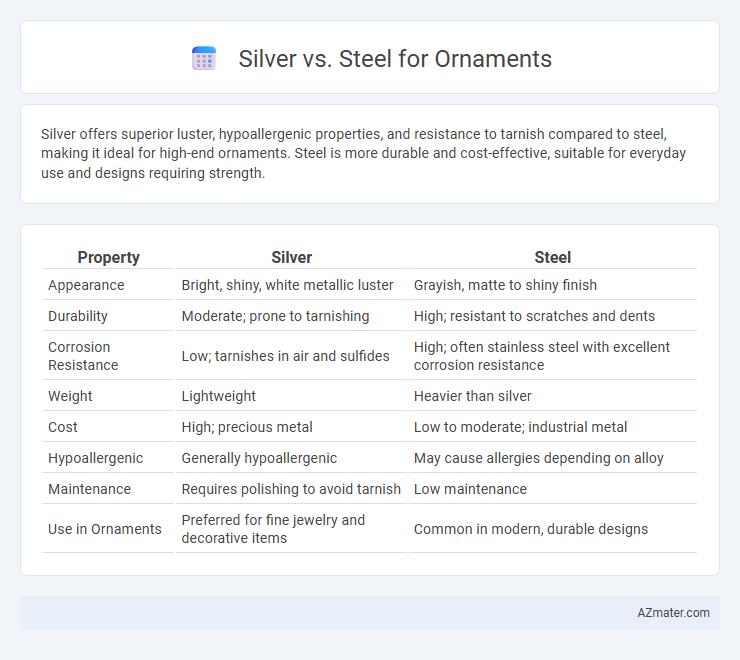Silver offers superior luster, hypoallergenic properties, and resistance to tarnish compared to steel, making it ideal for high-end ornaments. Steel is more durable and cost-effective, suitable for everyday use and designs requiring strength.
Table of Comparison
| Property | Silver | Steel |
|---|---|---|
| Appearance | Bright, shiny, white metallic luster | Grayish, matte to shiny finish |
| Durability | Moderate; prone to tarnishing | High; resistant to scratches and dents |
| Corrosion Resistance | Low; tarnishes in air and sulfides | High; often stainless steel with excellent corrosion resistance |
| Weight | Lightweight | Heavier than silver |
| Cost | High; precious metal | Low to moderate; industrial metal |
| Hypoallergenic | Generally hypoallergenic | May cause allergies depending on alloy |
| Maintenance | Requires polishing to avoid tarnish | Low maintenance |
| Use in Ornaments | Preferred for fine jewelry and decorative items | Common in modern, durable designs |
Introduction: Silver vs Steel in Ornamentation
Silver offers a timeless elegance and high luster that enhances ornamental designs, making it a preferred choice for fine jewelry and intricate craftsmanship. Steel, particularly stainless steel, provides exceptional durability and resistance to tarnish, ideal for contemporary and everyday wear accessories. The choice between silver and steel in ornamentation balances aesthetic appeal with practical functionality, depending on the desired style and longevity.
Historical Significance of Silver and Steel Ornaments
Silver ornaments have been treasured since ancient civilizations such as the Egyptians and Romans, symbolizing wealth, power, and spiritual protection due to their rarity and lustrous appeal. Steel ornaments emerged prominently during the Industrial Revolution, valued for their durability, affordability, and modern aesthetic, reflecting societal shifts towards functionality and mass production. The historical significance of silver underscores traditional prestige and ceremonial importance, while steel represents innovation and industrial strength in decorative arts.
Aesthetic Appeal: Shine, Texture, and Design Versatility
Silver offers a brilliant, reflective shine that enhances intricate designs with its smooth, lustrous texture, making it ideal for elegant and sophisticated ornaments. Steel provides a modern, sleek finish with a matte or polished look, featuring greater durability and a distinctive industrial aesthetic. Both metals allow versatile design options, but silver excels in traditional elegance while steel suits contemporary, minimalist styles.
Durability and Strength Comparison
Steel outperforms silver in durability and strength, making it more resistant to scratches, dents, and daily wear. Silver, while prized for its lustrous appearance, is a softer metal prone to tarnishing and deformation over time. For ornamental use where long-lasting structural integrity is essential, stainless steel offers superior resilience compared to the comparatively delicate silver.
Hypoallergenic Properties and Skin Safety
Silver, particularly sterling silver, is highly valued for its hypoallergenic properties, making it an excellent choice for sensitive skin as it rarely causes irritation or allergic reactions. Steel, especially surgical-grade stainless steel, is also hypoallergenic and widely used in body jewelry due to its resistance to rust, corrosion, and allergenic substances like nickel. Both metals offer safe options for ornamental use, but individuals with extreme metal sensitivities may prefer sterling silver to minimize the risk of skin irritation.
Maintenance and Tarnish Resistance
Silver ornaments require regular polishing to prevent tarnish caused by exposure to air and moisture, while steel ornaments exhibit superior resistance to rust and corrosion, demanding minimal maintenance. Stainless steel's durable and non-porous surface makes it ideal for everyday wear, maintaining its shine without frequent cleaning. Silver's softness makes it prone to scratches, necessitating careful handling compared to the robust nature of steel.
Price Point and Value Considerations
Silver ornaments generally offer a moderate price point, making them accessible while providing intrinsic value due to their precious metal content. Steel ornaments are typically more affordable and highly durable, offering exceptional value for budget-conscious buyers seeking long-lasting alternatives. The choice depends on balancing the elegance and investment potential of silver against the cost-effectiveness and resilience of steel.
Popular Uses in Modern Jewelry and Accessories
Silver is favored in modern jewelry for its lustrous shine, affordability, and hypoallergenic properties, making it ideal for rings, necklaces, and earrings often worn daily. Steel, particularly stainless steel, dominates in men's accessories due to its durability, corrosion resistance, and sleek, contemporary aesthetic used in watches, bracelets, and cufflinks. Both metals cater to different market segments, with silver appealing to classic elegance seekers and steel attracting those who prefer industrial, modern designs.
Environmental Impact and Sustainability
Silver mining generates less environmental pollution compared to steel production, which involves extensive energy use and CO2 emissions from iron ore extraction and processing. Silver is highly recyclable, reducing the demand for new mining, while steel, though recyclable, requires significant energy-intensive refining that contributes to greenhouse gas emissions. Choosing recycled silver ornaments can minimize ecological footprints more effectively than steel alternatives, supporting sustainable consumption in jewelry and decoration.
Choosing the Right Metal for Your Style
Silver offers a classic, elegant shine ideal for timeless, sophisticated styles, while steel provides a modern, durable look suited for edgy, contemporary designs. Silver is softer and more prone to tarnish, requiring regular care, whereas stainless steel is hypoallergenic, highly resistant to scratches and corrosion, making it perfect for everyday wear. Selecting between silver and steel depends on your lifestyle and aesthetic preferences, balancing maintenance needs with desired appearance and durability.

Infographic: Silver vs Steel for Ornament
 azmater.com
azmater.com